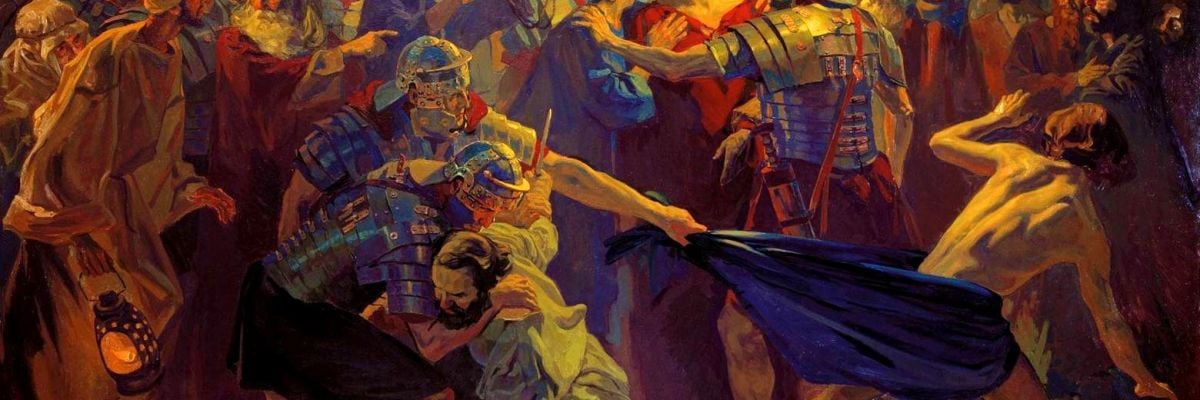
A few days ago I received the following e-mail query: What is the identity of the naked man in Mark 14:51-52?
This is one of those biblical mysteries that have always fascinated me, and I am certainly not alone in this. Believers have been puzzling over the identity of this young man in the linen garment for centuries.
For those of you who are unfamiliar with St. Mark’s account of the betrayal and arrest of Jesus, in it the Evangelist describes a mysterious figure: “a young man . . . with nothing but a linen cloth about his body” who was seized by the Roman soldiers and “ran away naked” (Mark 14:51-52).
Here is the immediate context of these verses:
43 And immediately, while he was still speaking, Judas came, one of the twelve, and with him a crowd with swords and clubs, from the chief priests and the scribes and the elders. 44 Now the betrayer had given them a sign, saying, “The one I shall kiss is the man; seize him and lead him away safely.” 45 And when he came, he went up to him at once, and said, “Master!” And he kissed him. 46 And they laid hands on him and seized him. 47 But one of those who stood by drew his sword, and struck the slave of the high priest and cut off his ear. 48 And Jesus said to them, “Have you come out as against a robber, with swords and clubs to capture me? 49 Day after day I was with you in the temple teaching, and you did not seize me. But let the scriptures be fulfilled.” 50 And they all forsook him, and fled. 51 And a young man followed him, with nothing but a linen cloth about his body; and they seized him, 52 but he left the linen cloth and ran away naked.
So who exactly is this young man? We simply do not have enough evidence from Scripture to determine who he is with any certainty. However, there sure has been a lot of speculation.
Who do men say that he is?
There are a variety of opinions. Let’s touch on a few:
Some say he’s James.
In The Great Biblical Commentary, the eminent Jesuit exegete Cornelius à Lapide explores the various opinions held by several Church Fathers: “You will ask who this young man was: Saint Epiphanius and Saint Jerome think that he was James the Lord’s brother.” Eusebius of Caesarea (the Father of Church History) writes that James wore a linen garment all his life, purportedly the one he abandoned in Mark 14.
Some say he’s John.
Lapide furthermore informs us that: “St. John Chrysostom, St. Ambrose, St. Gregory, and Baronius, think the naked man was St. John the Apostle; for he was a youth, and the youngest of the Apostles. Moreover, Saint John remained faithful all the way to the crucifixion.” Lapide goes on to reject this opinion saying, “That it was neither John nor James, nor any of the Apostles, is plain from this, that Mark has just before said, ver. 50, then all His disciples, meaning, Apostles, forsook Him and fled.”
Some say he’s Mark.
Lapide then moves closer to the predominant opinion held today, and the one I subscribe to: The naked young man in question is none other than Mark himself. “Theophylact and Euthymius think that the young man was some one from the house of John Mark, in which Christ had eaten the Passover. And more probably, Cajetan and others conjecture that this young man was a member or servant of a house adjacent to the garden, who, being awoke by the noise made by those who were apprehending Christ as they passed by, rose up from his bed, and ran to see what was being done. That he was a favourer or disciple of Christ appears from what Mark says, he followed Him.”
As I mentioned earlier, most biblical scholars and exegetes today hold that the young man in question is Mark himself. His Gospel is the only one that includes this particular detail, which is viewed by many as a personal signature of sorts. Some contend that the Last Supper took place in the home of Mark’s mother, Mary (see Acts 12:12). It is entirely plausible that Judas Iscariot may have returned there first to betray Jesus. We can then understand how Mark (dressed in nothing but a linen garment) was suddenly roused from his slumber and, recognizing the treachery that was unfolding, rushed to warn Jesus. Mark could have also been awakened by the commotion caused by the large crowd seeking Jesus and followed them to Gethsemane.
The following excerpt from A Catholic Commentary on Holy Scripture supports this theory:
Only Mark records this incident of the unnamed young man. He may have been roused from sleep by the crowd and followed them with a linen cloth wrapped about him. The fact that he followed our Lord in these circumstances suggests that he was a disciple or, at least, sympathetic to Christ. It is unlikely that mere curiosity explains his actions. Many writers hold that this is a personal reminiscence of the author of the Gospel and identify the young man with Mark himself. The insertion of this personal anecdote, which is not closely linked with either the preceding or the subsequent narrative, would be equivalent to the setting of Mark’s signature to the Gospel. The view is not certain, but it gives a reasonable explanation of an otherwise baffling narrative. It appears to be clear that we cannot identify the young man who figures in this incident with any of the Apostles—they had all fled.”
What particular theory do you subscribe to? Who do you say that he is and why?


